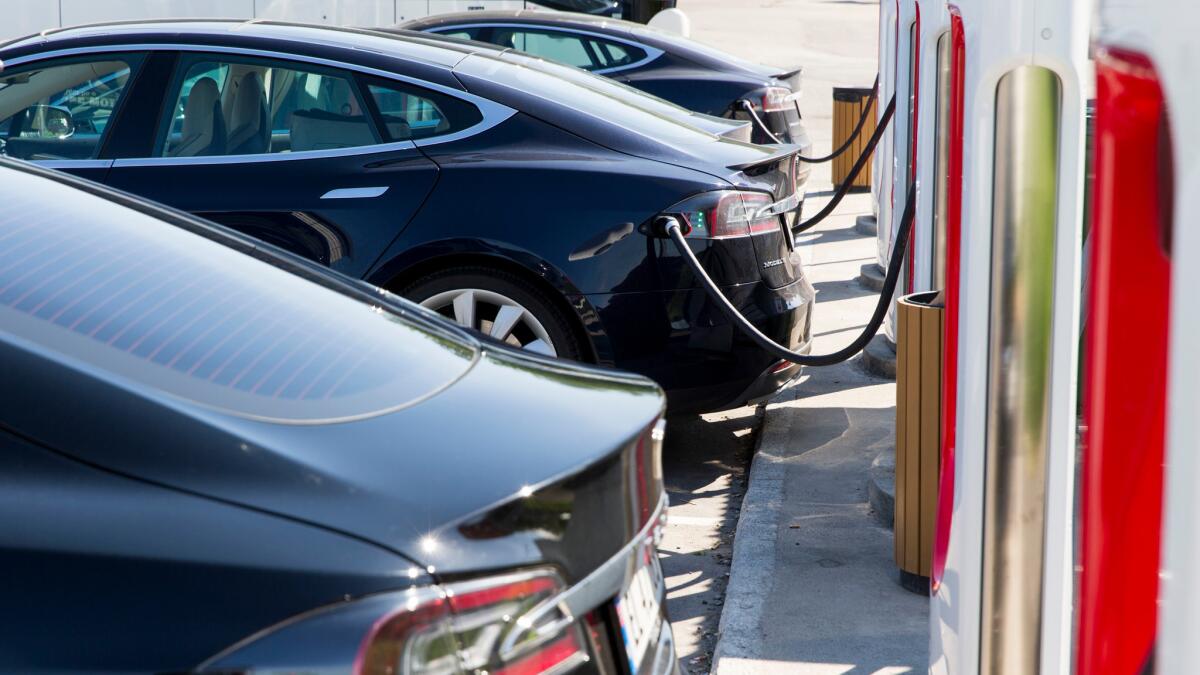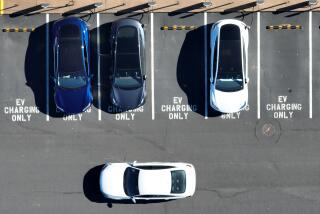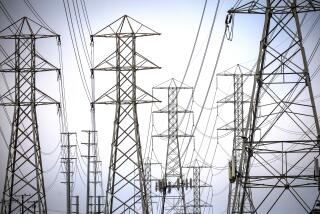How will I charge my electric vehicle? And where? And how much will it cost?

Here’s what you should know about charging a long-range electric vehicle.
With the impending late-2016 arrival of the Chevrolet Bolt EV and the expected late-2017 arrival of the Tesla Model 3, affordable long-range battery electric vehicles are an option for increasing numbers of American drivers.
But most prospective owners are confused about how they’ll charge their electric vehicles, and where, and how long it will take, and how much range they’ll get between charges and how much the electricity is going to cost them.
Their confusion is about more than a lack of familiarity with new technology. The EV charging infrastructure is a fractured, multifaceted monster, involving competing or even conflicting charging systems and equipment, and it is rife with complicated pricing schemes.
An EV owner charging at home on a regular 110-volt wall plug in one part of the city may pay an entirely different rate than another owner charging the same kind of vehicle, on the same kind of outlet, in a different part of the same city.
Rates will vary depending upon which utility the consumer uses, what rate plans are available and what time of day (or night) the vehicle is being charged.
Public station offerings are even more varied, including free 110-volt plug-ins at libraries, free 240-volt plug-ins at department stores and free 480-volt superchargers at Tesla charging stations — as well as myriad paid rates at privately run stations that often require special memberships or debit cards.
“People have been going to gas stations for a hundred years, but we’re just at the beginning of this technology,” said Genevieve Cullen, president of the EV trade group Electric Drive Transportation Assn. “Things seem confusing at first.”
Here is a primer on EV charging options.
HOME CHARGING, THE CHEAP WAY
A striking number of plug-in hybrid owners do all their charging at home, at night, on a simple 110-volt wall plug. Scott Briasco, of the Los Angeles Department of Water and Power’s EV program, said that more than half of the 20,000 plug-in EVs in the utility’s service area are charging this way.
It isn’t fast. Most cars charge at the rate of about 4 to 5 miles of range per hour. So, a mid-range vehicle like the Chevy Volt, with an all-electric range of 50 miles or so, will take 10 hours to completely recharge its battery.
This kind of charging is relatively inexpensive and requires no special equipment. (The vehicles usually are sold with an extension cord.) Owners drive home, plug in, recharge overnight and drive on.
What do they pay? It depends. Some utilities offer special EV deals, which allow vehicles to be charged at a lower rate. Others offer special “time of use” plans, which allow vehicles to be charged at night, when electricity demand is low, at lower rates.
Charging at an average low rate of 12 cents per kWh, for example, it would cost about $2.40 to bring a Nissan Leaf up to full charge, or about $3.50 to charge 100 miles worth of range into a Chevy Bolt EV.
That compares very favorably with gasoline-powered car costs. In a vehicle that gets 25 to 30 miles per gallon, with gas at the current California state average price of $2.75 a gallon, that 100 miles of range would cost $9 to $11.
Other costs are involved. The average EV costs more than its gasoline-powered equivalent — sometimes several thousand dollars more — but those EV purchase prices are somewhat offset by state and federal rebates or tax credits.
There are sometimes unexpected cost savings.
Eric and Jennifer Berkowitz began leasing a Fiat 500e plug-in electric in late 2015 from a dealer near their San Francisco home. They qualified for a special EV rate from Pacific Gas and Electric, which allowed them to charge the Fiat cheaply, overnight, plugging into a wall plug in their garage.
But they soon realized they also could run their heavy appliances at night, at the same EV rate. The result: No more visits to the gas station and a reduction in their total electric bill.
“Our usage went way up, but our total bill actually went down,” Eric Berkowitz said. “I think I spend more on lettuce than I do on my car.”
HOME CHARGING, THE FAST WAY
Pure battery electric vehicles have larger batteries than hybrid plug-ins and longer ranges, and they require more charging time.
So, some EV owners elect to install dedicated 240-volt chargers in their garages. These can cost from $300 to $800, plus installation costs that, depending on the age of the home and other factors, can run an additional $1,000 or more.
These costs can be somewhat offset by rebates, offered by many utilities to encourage home charging. (The Los Angeles Department of Water and Power is offering up to $500 in rebates and will throw in $250 more if the consumer invests in a dedicated meter. This rebate can rise to $80,000 for business owners who install multiple chargers at their commercial locations.) Other organizations, like the South Coast Air Quality Management District, also offer incentives.
Home owners who go this route can charge at a much faster clip. An EV with a 100-mile range, for example, could recharge at the rate of 20 to 25 miles per hour and go from empty to full in only four to five hours.
I don’t think I will ever go back to a gas vehicle.
— Gail Forcone, drives a 2015 Chevrolet Spark EV
How much will that cost? The fast-charge electricity costs the same as slow charge, but as with the 110-volt home charging, the price can vary widely.
While some utilities offer online calculators to help customers determine whether they could save by going electric, and how much, the rates at LADWP will not be the same as those charged by Southern California Edison or Pacific Gas and Electric.
“It’s not as simple as the gasoline system we have now,” said David Reichmuth, senior engineer at the Union of Concerned Scientists. “Electricity pricing is all over the map. It’s hard to figure out.”
A typical Southern California Edison customer on the utility’s EV plan, said spokesman Paul Griffo, spends $142 for a month’s worth of electricity — with $29 of that going toward charging the vehicle.
Overall, Reichmuth and others say, EV users are saving money on fuel costs. The nonprofit electric vehicle organization Plug In America, comparing gasoline rates to electricity rates, puts the fuel savings at the equivalent of $1.10 per gallon for a California EV owner who’s charging at home.
But it depends where they live. An EV owner in Hawaii, where electricity is expensive, could actually pay more to charge an EV than run a car on gas, while in the state of Washington, where electricity is cheap, gasoline energy costs four times the equivalent in electricity.
Kevin Wood, clean transportation manager for the Center for Sustainable Energy, said that of EV owners surveyed, 60% say they went electric to save on fuel costs — compared with far fewer who had environmental motives or were mostly interested in getting HOV lane access.
“Saving money on fuel costs is the No. 1 reason” for most EV purchases, Wood said. “But people who bought Priuses had a higher rate of the carpool lane being more important than the environment.”
CHARGING IN PUBLIC
Some EV users live in apartment buildings and have no access to home chargers and no way to install them.
But they still can take advantage of charging at public locations. Some businesses offer charging for their employees. Many libraries, colleges, post offices and public utility offices offer 110-volt charging or 240-volt faster charging — for free.
But mostly the available juice is privately controlled. Companies like ChargePoint, EVgo, Blink, Greenlots and others build and maintain charging stations, open to the public, where batteries can be recharged on demand.
At these locations, 240-volt Level 2 and 480-volt Level 3 “fast chargers” can bring a battery-only electric vehicle up to charge much faster than many home units. A Level 3 charge can restore 80% of battery capacity in a half-hour.
But unlike a gas station, you don’t just roll up and start pumping energy. At most of these stations, users first must register with the operating company and obtain a PIN, membership number or dedicated charge card, or download an app to a smartphone.
Sometimes, the electricity if free. ChargePoint CEO Pasquale Romano said 65% of his company’s 30,000 charging locations — in the workplace, at retail stores or civic buildings — dispense electricity at no charge.
But there’s no guarantee that a charge port will be available when you need one.
Phil Jamtaas usually charges his leased Nissan Leaf at home on a 240-volt system that takes five to six hours to restore the car’s 107-mile range. He also uses a free fast charger dispenser at a local DWP building.
“But it’s getting more well-known lately,” Jamtaas said. “Sometimes I arrive, and there are two cars already waiting.”
The Web service PlugShare can help, by supplying real-time online information about the nearest charging stations, how many ports are open and how much they charge. (Some manufacturers include software that gives this same basic information on the vehicle’s navigation screen.) The ChargePoint network also has begun offering a “waitlist” program, which allows members to reserve a place in line at a station of their choice.
The rates vary. At the Glendale City Hall building, for example, Level 3 fast charging is available via a Greenlots system at 34 cents per kWh.
Just around the corner, at a Vons supermarket, a similar system maintained by ChargePoint will do the same kind of charging for as low as 17 cents a kWh. But that rate rises to 31 cents per kWh during the 4-7 p.m. peak period, and it’s 50 cents per kWh for those hours during the summer.
Even the same company can charge differently at different locations. At one Blink-operated garage in downtown Los Angeles, the rate is 49 cents per kWh, according to its website, while at another, the rate is $4.99 per hour.
At the LADWP’s downtown Los Angeles John Ferraro building, 12 fast-charger ports are available — and there’s no charge for using them. But the free electricity runs only from 7 a.m. to 6 p.m. and only on weekdays.
Gail Forcone, of Placentia, drives a 2015 Chevrolet Spark EV. The battery electric vehicle has a range of about 80 miles per charge, more than enough to get Forcone back and forth to work every day. While she prefers to plug in at home, Forcone said sometimes she forgets and has to hit the quick charge, where a 20- to 30-minute wait brings her up to full range.
Forcone, who pays $15 a month for her membership in the EVgo charge network and about 10 cents a minute to use the quick charger, said that some months, her quick-charge bill is $30. Other months, she doesn’t use the network at all.
“I don’t think I will ever go back to a gas vehicle,” she said.

THE SUPERCHARGERS
Not all battery electric vehicles are alike. They don’t all charge at the same speed, and they don’t all use the same equipment. So, while a Nissan Leaf, Kia Soul EV or Mitsubishi iMiEV can use a CHAdeMo Level 3 fast charger, a Chevy Volt cannot. The Bolt EV, when it’s here, will have a DC fast-charger adapter as a $750 option, but using the CCS Combo, not the CHAdeMo system.
A number of EVs can restore their batteries to 80% or 90% capacity in 30 minutes on a Level 3 fast charger. A Tesla parked at a Tesla Supercharger station can do it even faster. And it’s free.
The Silicon Valley-based premium carmaker allows its Model S sedans and Model X crossovers to restore their batteries to capacity at no charge. But only Tesla vehicles can be connected to the supercharger system and its proprietary hardware.
Tesla has said it will not offer the same kind of free supercharger network to purchasers of base-price models of its more affordable Model 3 electric sedan, a proposed $35,000, long-range electric vehicle that Tesla could begin selling by late next year.
By then, more people may be driving Bolts and other EVs coming from other manufacturers. There will be more public charging stations for them to use.
ChargePoint’s Romano, who charges his Tesla Model S at his Los Gatos, Calif., home, said he feels good about the future.
“We have built a good business on a small amount of cars,” he said. “With more and better-priced [electric] models ahead, this will make a very large business for ChargePoint, and we can help feed that virtuous cycle of more people buying more of those cars.”
Twitter: @misterfleming
ALSO
U.S. to release guidelines on driverless vehicles
Chevy Bolt EV range is 238 miles: Prime time for the electric car?
Will Hyundai’s eco-friendly Ioniq woo hearts away from Prius?







